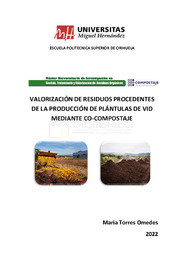Por favor, use este identificador para citar o enlazar este ítem:
https://hdl.handle.net/11000/28374Registro completo de metadatos
| Campo DC | Valor | Lengua/Idioma |
|---|---|---|
| dc.contributor.advisor | Pérez Murcia, Mª Dolores | - |
| dc.contributor.advisor | Martínez Sabater, Encarnación | - |
| dc.contributor.author | Torres Omedes, María | - |
| dc.contributor.other | Departamentos de la UMH::Agroquímica y Medio Ambiente | es_ES |
| dc.date.accessioned | 2022-11-16T08:18:31Z | - |
| dc.date.available | 2022-11-16T08:18:31Z | - |
| dc.date.created | 2022-09 | - |
| dc.identifier.uri | https://hdl.handle.net/11000/28374 | - |
| dc.description.abstract | El objetivo del trabajo es estudiar la valorización, mediante compostaje, de sarmientos de vid junto con destríos de cítrico y caqui y gallinaza con la finalidad de mejorar su gestión y la calidad del producto obtenido, así como investigar la minimización en el uso de estiércol en las mezclas de compostaje. Para alcanzar los objetivos planteados se diseñan tres ensayos de compostaje a escala real con diferentes proporciones de los ingredientes, aumentando la cantidad de destríos y disminuyendo la de gallinaza. El diseño experimental seguido consiste en la caracterización inicial de los residuos a compostar, el establecimiento de la mezcla a compostar, el desarrollo del sistema de compostaje mediante tres pilas volteadas y el análisis de las características fisicoquímicas y químicas de los materiales a compostar a lo largo del proceso, así como del producto final obtenido. El compostaje con mayor diversidad de ingredientes mejora la calidad y capacidad fertilizante de los compost en comparación con la mezcla binaria, lo que permitirá reducir la aplicación de fertilizantes minerales complementarios. Además, permite disminuir la cantidad de estiércol utilizado en el compostaje y, con ello, los costes para el agricultor que necesite gestionar los residuos derivados de su actividad económica | es_ES |
| dc.description.abstract | The objective of the work is to study the recovery, through composting, of vine shoots together with citrus and persimmon waste and chicken manure in order to improve its management and the quality of the product obtained, as well as to investigate the minimization in the use of manure in composting mixes. In order to reach the stated objectives, three full-scale composting trials are designed with different proportions of the ingredients, increasing the amount of waste of fruits and decreasing the amount of chicken manure. The experimental design followed consists of the initial characterization of the waste, the establishment of the mixture to be composted, the development of the composting system using three overturned piles and the analysis of the physical-chemical and chemical characteristics of the materials to be composted throughout the process, as well as the final product obtained. Composting with a greater diversity of ingredients improves the quality and fertilizing capacity of the composts compared to the binary mixture, which will reduce the application of complementary mineral fertilizers. In addition, it allows to reduce the amount of manure used in composting and the costs for the farmer who needs to manage the waste derived from his economic activity | es_ES |
| dc.format | application/pdf | es_ES |
| dc.format.extent | 102 | es_ES |
| dc.language.iso | spa | es_ES |
| dc.publisher | Universidad Miguel Hernández de Elche | es_ES |
| dc.rights | info:eu-repo/semantics/openAccess | es_ES |
| dc.rights.uri | http://creativecommons.org/licenses/by-nc-nd/4.0/ | * |
| dc.subject | Compostaje | es_ES |
| dc.subject | Residuos orgánicos | es_ES |
| dc.subject | Sarmientos | es_ES |
| dc.subject | Vid | es_ES |
| dc.subject.other | CDU::6 - Ciencias aplicadas::63 - Agricultura. Silvicultura. Zootecnia. Caza. Pesca::631 - Agricultura. Agronomía. Maquinaria agrícola. Suelos. Edafología agrícola | es_ES |
| dc.title | Valorización de residuos procedentes de la producción de plántulas de vid mediante co-compostaje | es_ES |
| dc.type | info:eu-repo/semantics/masterThesis | es_ES |

Ver/Abrir:
TFM Torres Omedes, María.pdf
4,26 MB
Adobe PDF
Compartir:
 La licencia se describe como: Atribución-NonComercial-NoDerivada 4.0 Internacional.
La licencia se describe como: Atribución-NonComercial-NoDerivada 4.0 Internacional.
.png)